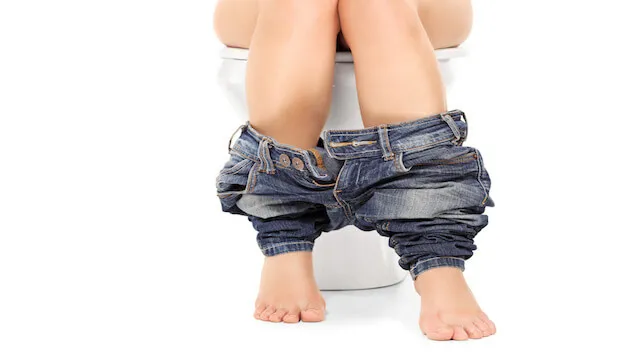Sit, squat or lean, a question that’s plagued humans for centuries — not really — but maybe it should have. While it’s no secret we all poop, it’s really not something most of us care to discuss, except with our doctor. Yet, history and research tells us there may be a better way to poop, and knowing which method is best, could mean less straining and even avoiding certain pressure diseases.
Straining to poop
Did you know that the modern toilet might be to blame for a number of serious ailments? Constipation, something we all suffer from time to time, could be the result of eliminating our bowels while sitting on the common toilet seat, suggests research published in the U.S. National Library of Medicine titled, “Primary Constipation: An Underlying Mechanism.”
Even with frequent bowel movements, many people have difficulty emptying their bowels, which may be caused by the recto-anal angle and its relationship with the sitting posture. We all have a kink at the end of our rectum, a 90-degree angle that stops us from pooping ourselves whenever we have the urge to go. However, the angle only slightly straightens when we are sitting on the toilet, leaving us straining to eliminate our bowels.
Bowel movements should be effortless, but they’re not. Essentially, the only natural posture for pooping is squatting, which aligns the recto-anal angle, providing smooth bowel elimination and preventing straining. Habitual excess straining can lead to pressure diseases such as diverticulitis, hemorrhoids, hiatal hernia and varicose veins. So, if sitting isn’t the best method for pooping, should we lean or squat? Well, first we need to find out what got us here.
The porcelain throne
To understand the difference between sitting, squatting and leaning during elimination, we must first understand how the modern-day toilet came to be — and why it might not have been such a great invention for human physiology.
Did you know that originally the sitting toilet was only used for royalty and the disabled? However, after the development of indoor plumbing in the 1800s, the water closet, with its throne-like seating, was adapted to fit the average household to give us ordinary folk the luxury of pooping with dignity, just like the kings and queens. Prior to that, our ancestors were squatting to relieve themselves, just as they had done since the dawn of time.
Using potty stools
Here’s the problem, while Western society has adapted to modern toilets, our bodies haven’t, because ultimately our bodies were made to squat. The sitting position makes pooping difficult and incomplete, forcing us to strain. Yet, if Queen Victoria was pooping that way, no one was going to argue. So, it was accepted begrudgingly, as indicated by the popularity of the “squatting stool” sold in the famous department store, Harrods of London. Although somewhat crude, the squatting stool was an attempt to elevate the feet and imitate squatting. Does this mean you should run out and buy a squatting stool? No.
One study compared the straining forces applied when sitting or squatting during defecation. Healthy volunteers with normal bowel functions recorded how long it took them to empty their bowels in three positions: sitting on a standard-sized toilet seat, sitting on a lower toilet seat and squatting. They were also asked to record the intensity of the defecation effort in each position. The result: squatting was the only satisfactory method for emptying the bowels without strain — stools of various heights did little to improve defecation.
Sitting or leaning

Constipation is the result of hard stool unable to pass; so this method is ideal for anyone who suffers from constipation. Nevertheless, instead of suffering, why not improve your diet and eliminate constipation altogether.
Eliminate constipation
The Western diet is largely the cause of constipation, suggests a study titled “Dietary Fiber and Disease” published in the Journal of the American Medical Association (JAMA). The types of foods we consume affect how long it takes us to poop and the consistency of our stool — hard or soft. Not eating enough fiber could cause constipation and chronic straining, which in turn could explain occurrences such as ischemic heart disease, appendicitis, diverticular disease, gallbladder disease, varicose veins, deep vein thrombosis, hiatus hernia, and tumors of the large bowel.
For a healthy diet that’s full of fiber, eat whole, plant-based foods such as vegetables, fruits, nuts, seeds, legumes and beans. Fiber is not only essential for eliminating effortlessly, but also the most essential nutrient for healthy blood sugar, heart health and digestion. Keep in mind, however, consuming too much fiber too fast may cause digestive upset. So if you’re not used to eating lots of whole, high-fiber, plant-based foods, go slow and work more high-fiber foods into your diet daily.
Today, the concept of squatting may seem foreign; however, this is actually the way our human bodies were designed to poop. And while leaning forward may be the closest thing to squatting, truth be told, neither squatting or leaning forward prevents pressure diseases like varicose veins or a hiatus hernia. So while squatting and leaning can help straighten the recto-anal angle, a healthy enough diet should make bowel movements effortless regardless of positioning. Enjoy a healthy diet and your digestive system will work better, and you’ll poop better.
—Katherine Marko
Katherine Marko is a freelance writer, author and blog creator. Her areas of expertise include food, health, style, beauty, business and nutrition. Marko holds a Bachelor of Arts in English, a diploma in photography, graphic design and marketing, and certification in esthetics.
Sources:
http://www.naturesplatform.com/health_benefits.html#r19_24
http://www.ncbi.nlm.nih.gov/pubmed/2927355
http://journals.lww.com/dcrjournal/Pages/toc.aspx?year=1966&issue=09060.
http://jama.jamanetwork.com/article.aspx?articleid=356292
http://www.medicinenet.com/script/main/art.asp?articlekey=9312
http://www.ncbi.nlm.nih.gov/pubmed/25748875
